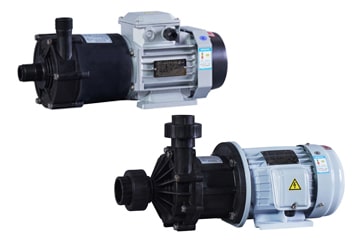Magnetic drive pumps are a kind of seal-less pumps applying the principle of permanent magnetic drive technology to realize contactless transmission of torque. Also known as mag drive pump, magnetic coupling pump and magnetic sealless pump.
“Magnetic drive” refers to the coupling between the wet end of the pump and the motor, replacing the dynamic seal with a static seal, so that the pump reaches a completely leak-free. It is especially suitable for conveying flammable, explosive, volatile, toxic, corrosive and valuable liquids. AOBL is a professional manufacturer of magnetic drive pumps, mainly providing all kinds of magnetic drive centrifugal pumps.
magnetic drive pump working principle
Magnetic drive pumps utilize the characteristics that magnets can attract ferromagnetic substances and that there is a magnetic force between magnets or magnetic fields, which can transmit power through a non-magnetic conductor (isolation sleeve) without contact. Magnetic drive pump is mainly composed of pump body, impeller, magnetic coupling, isolation sleeve, electric motor and so on.
The electric motor is connected to the outer magnet through the shaft coupling. The impeller and the inner magnet are integrated with the pump shaft through the impeller nut and are mounted in the sealing body composed of the pump body and the isolation sleeve. The motor drives the outer magnet, and the outer magnet drives the inner magnet to rotate the impeller, thus replacing the dynamic seal by the static seal to achieve leakage-free conveying medium.

magnetic drive pump uses
- Chemical industry: sodium carbonate chemical industry, chemical fertilizers, oil and grease refining (sulfuric acid), the recovery of waste acids and the transportation of strong acids between chemical plants and transport vehicles.
- Pharmaceutical industry: semiconductor light-emitting chemicals, pharmaceuticals, water treatment chemicals production.
- Electroplating industry: circulating and filtering all kinds of electroplating solution.
- Etching process of circuit board, semiconductor production process conveying high purity chemical liquid.
- Metal industry: aluminum oxide film treatment equipment, wire drawing, steel rolling in the degreasing and pickling, vehicle painting before degreasing and pickling treatment, the production of titanium oxide elements.
- Water treatment industry: wastewater treatment system, pure water production equipment and equipment.

magnetic drive pump advantages and disadvantages
advantages
- Magnetic pumps can have overload protection in the process of transferring power.
- The maintenance and overhaul workload of magnetic drive pump is relatively small.
- In addition to the magnetic material and magnetic circuit design has high requirements, other parts of the technical requirements are not so high.
- The drive shaft does not need to penetrate into the pump casing, but through the magnetic field through the air gap and the thin wall of the isolation sleeve to transfer the torque to drive the inner rotor, which eliminates the leakage of the shaft seal, and can realize the full seal.
disadvantages
- Magnetic pump coupling has high requirements for centering, when misalignment will cause damage to the bearing at the inlet and wear of the isolation sleeve.
- The material and manufacturing requirements of the isolation sleeve are relatively high. If the material is not selected properly to cause the isolation sleeve can not withstand the friction of the inner and outer magnetic steel is easily worn, if the rupture of the pumping medium will leak.
- The efficiency of magnetic pumps and general centrifugal pumps, compared with the efficiency of magnetic pumps will be lower.
magnetic drive pump vs centrifugal pump
- Magnetic pumps without shaft seal (or mechanical seal).
- Standard centrifugal pumps do not contain a magnetic rotor.
- Magnetic pumps are designed to prevent leakage, while standard centrifugal pumps are prone to leakage after a long period of operation.
- Magnetic pumps cannot convey liquids containing solid particles.
- Energy consumption is not the same. Magnetic pumps do not have a large number of heating conditions occur when working. The traditional motor-driven mode will emit a lot of heat in the work.
- Efficiency is not the same. Magnetic pumps use synchronous drag, there will be no friction in the working process, there is no resistance, so the power consumption is relatively small, which also improves efficiency. Centrifugal pump is driven by the motor, there will be a lot of friction at the time of use, with the use of a long time, there will be a certain resistance, the lack of lubricants or cooling water is more serious, it will reduce the efficiency of the work.




